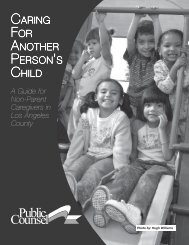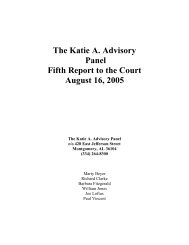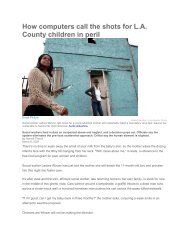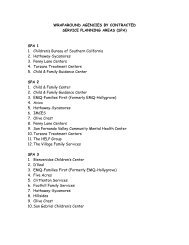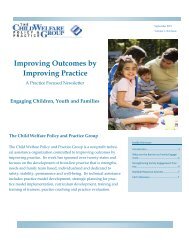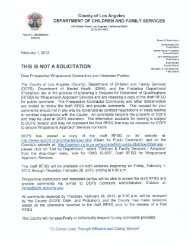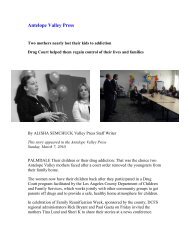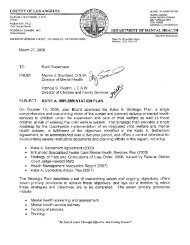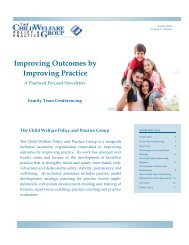DCFS News Winter Issue (PDF) - Los Angeles County Department ...
DCFS News Winter Issue (PDF) - Los Angeles County Department ...
DCFS News Winter Issue (PDF) - Los Angeles County Department ...
You also want an ePaper? Increase the reach of your titles
YUMPU automatically turns print PDFs into web optimized ePapers that Google loves.
Amaryllis Watkins Named Newest<br />
Member of Executive Team<br />
Long-time Social Worker Brings Unique Perspective to Management<br />
“A<br />
fter 37 years as a social worker, I am more<br />
enthusiastic about child welfare than ever before,”<br />
said Amaryllis Watkins, the newest <strong>DCFS</strong> Deputy<br />
Director for Service Bureau 2. From her perspective, Watkins<br />
sees social welfare coming full circle. “We are back to focusing on<br />
families and providing service to children in their homes,” she<br />
said. “When children can’t be kept in or be returned to their homes<br />
then they should have safe and loving homes of their own.”<br />
Social welfare is evolving, but Watkins’ core belief remains that<br />
people can grow and change. As long as we look for their<br />
strengths and don’t give up on them, they have a chance and the<br />
community is better off, she said. Team Decision-Making is a<br />
critical, key component to empowering families. This is the<br />
essence and focus of what she will bring to <strong>DCFS</strong> Service Bureau<br />
2, which includes the Compton Project and Point of<br />
Engagement/Multidisciplinary Assessment Team, Child Protection<br />
Hotline, Emergency Response Command Post/Out-of-<strong>County</strong><br />
Services, Service Planning Areas 4, 5 and 6 and the Katie A.<br />
Program.<br />
Watkins believes the goal of leadership is to demonstrate the<br />
ON THE LINE<br />
O<br />
“<br />
After 13 years of being on the line as a Children’s Social<br />
Worker, Hai Luu says with great humility, “The more I<br />
work, the more I like this job.” Luu has been with the<br />
Asian Pacific Unit for 12 years. Supervisor S.Y. Woo explains that<br />
Luu has gone above and beyond the call of duty by taking the<br />
initiative to staff foster parent recruitment booths at community<br />
events, obtain tickets for shows for social workers to give<br />
to children and collect toys for <strong>DCFS</strong> families at the<br />
holidays.<br />
The first year Luu was with the department, he<br />
was a Command Post worker. Working at night<br />
when the most critical calls came in was<br />
very exciting for Luu and served as a great<br />
training ground.<br />
Within the Asian-Pacific community,<br />
there are many similarities among<br />
Asian cultures, but there are more<br />
differences, explains Luu. Therefore,<br />
the Asian Pacific Unit serves a very<br />
important purpose including helping<br />
reduce unnecessary detentions<br />
w i t h i n t h e A s i a n - P a c i fi c<br />
Hai Luu<br />
tools that can help to accomplish<br />
these beliefs. Teamwork is also a<br />
key to success and is the result of<br />
leadership who demonstrate it.<br />
Recent changes at the Command Post<br />
are a good example of successful<br />
departmental teamwork. “By focusing on<br />
the issues at hand, working with regional<br />
Children’s Social Workers and managers, our<br />
Bureau of Resources staff and community resources,<br />
Command Post has been better able to quickly place the<br />
children who come through their office.”<br />
Amaryllis Watkins<br />
A year from now, Watkins hopes that as a department we will<br />
be focusing on highest-risk cases, maintaining kids in their homes<br />
and having the fewest children in congregate care and then only<br />
those with the highest needs. Children who need to be placed will<br />
remain in their communities and workers will feel an even greater<br />
sense of accomplishment. “Another way to move towards this goal,”<br />
said Watkins, “is to all demonstrate empathy and understanding for<br />
each other and take this outside to the community.”<br />
n the Line" is a "<strong>DCFS</strong> <strong>News</strong>" column featuring <strong>Los</strong> <strong>Angeles</strong> <strong>County</strong> <strong>Department</strong> of Children and Family Services social<br />
workers whose achievements and practices epitomize the best in social work.<br />
Personal Life Experiences Help Asian Pacific Unit<br />
Social Worker Connect with the Community<br />
community due to cultural misunderstandings.<br />
He also believes that the unit builds cross-cultural bridges by<br />
providing information and making families aware of U.S. laws and<br />
customs. By actively getting involved in the community, the unit<br />
helps children have better lives with less abuse and neglect from<br />
their caretakers.<br />
Physical abuse is the biggest issue within the Asian-Pacific<br />
community, said Luu. Within the Asian-Pacific culture there are no<br />
specific words assigned for feelings, so working through<br />
Western-focused therapy does not work. What does work, he said,<br />
is presenting an issue in the context of how it may impact the<br />
family’s political or financial status. That method, Luu said, gets<br />
faster results.<br />
Luu brings a great deal of life experience and cultural<br />
background to his job. He has straddled two Asian cultures from<br />
birth. Luu was born to a Vietnamese mother and a Chinese father<br />
who ran to Vietnam to escape the Japanese during World War II.<br />
He served in the South Vietnamese army during the Vietnam War.<br />
After the war in 1979, he his wife and two babies fled Vietnam as<br />
boat people and made their perilous way to Hong Kong and then<br />
to Louisville, Ky. He hopes to retire in five years to teach social<br />
work and write his life story.<br />
5



